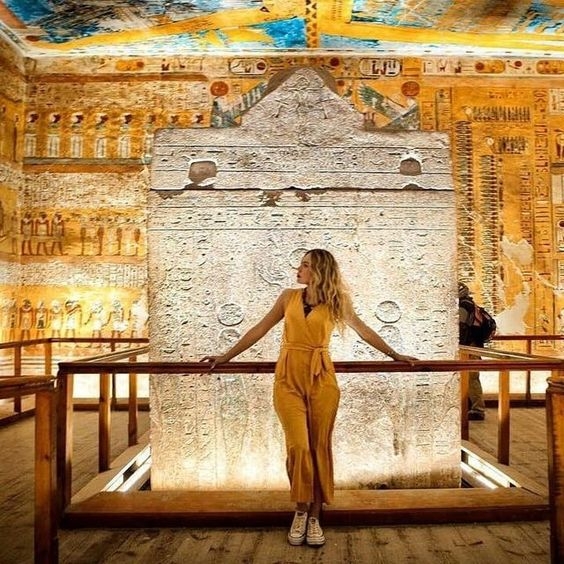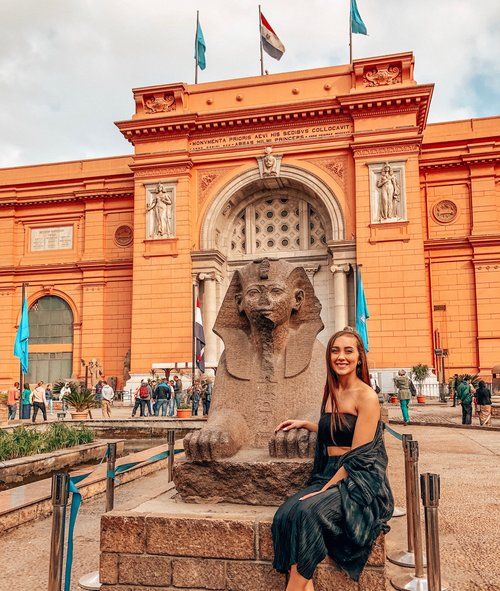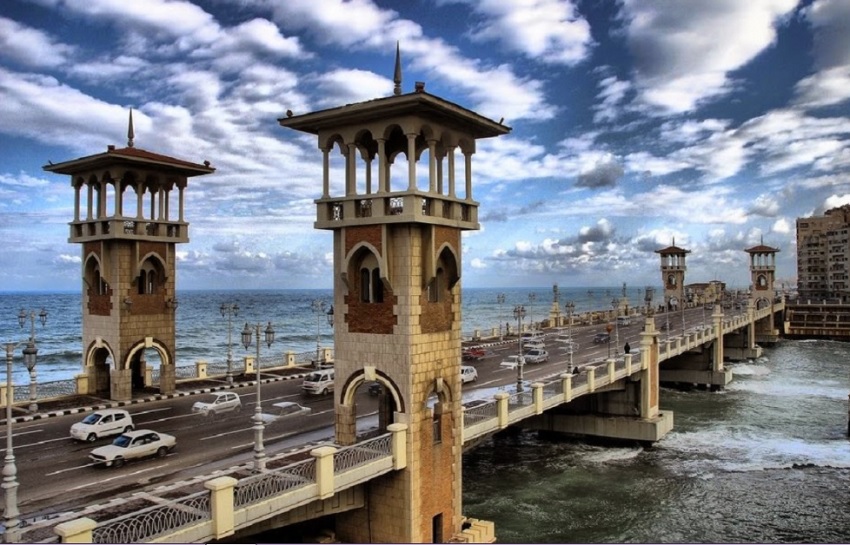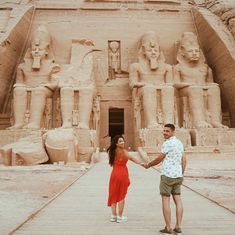
8 Days in Egypt in Easter
8 Days in Egypt in Easter
Traveling during the holidays is a fantastic experience that combines cuisine, decorations, traditions, celebrations, and every kind of diverse blend one can find. Egypt is a country with a majority of Muslims, so you might not think about it around Easter. However, you'll find that Egyptians get into the holiday atmosphere.
For the 2023 New Year's and Easter Tours in Egypt, we have fantastic vacation offers. Visit Egypt's most well-known landmarks this Easter and create lifelong memories with Plan Egypt Tours.
Cairo (Day 1)
Visit Pyramids of Giza, one of the seven wonder of the world, were constructed on one of the rockiest plateaus on the banks of the Nile in Northern Egypt, served as the necropolis for the royalty of the old kingdom, the pyramid structure represents the evolution for tomb design, built to endure eternity for another life
Giza plateau are funerary structures of three kings of the fourth dynasty, Comprised of pyramids, tombs complexes and workers' residence, the solar boat museum, and the great sphinx
Saqqara, Memphis and Egyptian Muesum (Day 2)
The name of Memphis is derived from the Ancient Egyptian name called Min-Nefer, then Greeks called it latter Memphis. Nowadays it is a local village called Mit Rahina.
It was founded in the 1st Dynasty (3100 B.C) by King Narmar, Memphis was the capital of Ancient Egypt, and the first capital city founded after the unification of Upper and Lower Egypt. It remained as the capital of Ancient Egypt throughout the Old Kingdom.
The Egyptian museum located in Tahrir Square, houses an unbelievable exhibit over 120,000 artefacts, which depicting ancient Egypt's glorious reign. Mummies, sarcophagus, pottery, jewellery and of course King Tutankhamun's treasures, this vast heritage is revealed in all its unparalleled glory hundreds of magnificent full-color photographs with special lighting techniques.
Egyptian museum founded in the 19th century by the French Egyptologist Auguste Mariette, to halt the plundering of archaeological sites and to arrange the exhibition of the collected artifacts, The Azbakian garden in Cairo was first used as a storage place for these artifacts, a museum was prepared at Boulaq, then transferred to an annex of the Giza palace of Ismail pasha, The present museum was built in 1900, in the neoclassical style by the French architect Marcel Dourgnon

citadel of Salah El Din, Cairo Tower and Amr Ibn Al-As Mosque (Day 3)
The citadel of Salah El Din is the seat of government and major Headquarters of Salah El Din, medieval fortress, with large imposing gateways, towers and high defending walls
The Citadel was fortified by the Ayyubid ruler Salah al-Din to protect them from Crusaders, Saladin set out to build a wall surround both Cairo and Fustat. Built on a promontory beneath the Muqattam Hill.
The citadel has three main areas: the main fortress and eastern walls, which were built by the great Salahedin El-Ayyoubi in 1176, the southern enclosure with 19th century walls and the lower enclosure extending down the western face of the hill.
.png)
Cairo Tower is a free-standing concrete tower in Cairo, Egypt At 187 m, it has been the tallest structure in Egypt and North Africa for about 50 years. It was the tallest structure in Africa for ten years until 1971, when it was surpassed by Hillbrow Tower in South Africa, Cairo Tower was built in the reign of former Egyptian president Gamal Abdel Nasser. It cost 6 million pounds at the time it was built in the late 60s.
The tower consists of 16th floors which were built on a huge Aswan granite base where the Pharos used to build fascinating temples and structures, this tower is located at a place in Cairo which is called El Gizera, it also was constructed by Naoum Shebib at 1961.
The superb Amr Ibn Al-As Mosque considered the first Mosque built in Egypt, It was built in Al-Fustat, known as Crown of the Mosques, Erected in 642 AD (21 AH) by Amr Ibn al As, also not only used for worship, but used as a court for settling religious and civil disputes for islamic khalifa.
The original structure was rectangular built with a low shed of wood and palm leaves supported on columns of palm stems, stones, and mud bricks while the floor was covered with gravel, present mosque is a 19th-century reconstruction that still preserves design elements and work from various periods of the building’s history.

Alexandria city(Day 4)
Alexandria, Egypt’s second capital, is a true Mediterranean jewel that hovers between illusion and reality, it’s the city developed from a mere anchorage to “The Pearl of the Mediterranean” Alexandria has first come to existence when the young Macedonian leader Alexander the Great choose it to become the capital of Graeco- Roman Egypt in 332 B.C. It wasn’t only an ancient Egyptian center for learning, but it was also a historical site
Alexandria is situated on the Mediterranean coast of Egypt, 179km (111 miles) north of Cairo, From the 19th century Alexandria took a new role, as a focus for Egypt's commercial and maritime expansion, it was home to a lighthouse ranking among the Seven Wonders of the Ancient World as well as a storied library.
Luxor city(Day 5)
Luxor City Located in Upper Egypt, has been described as the world’s biggest open-air museum, Luxor contains about a third of the most valuable monuments and antiquities in the whole world, which makes it one of the most important tourist sites. Luxor Monuments such as The Luxor Temple, Karnak Temple, Valley of the Kings, Valley of the Queens, El Deir El-Bahri (the Mortuary Temple of Hatshepsut), the worker's village at Deir El-Medina.
Luxor city(Day 6)
Karnak Temple is one of the largest temple complexes in the world. This magnificent Temple has incredibly rich architectural and it was covering about 200 acres (1.5 km by 0.8 km), and was a place of pilgrimage for nearly 2,000 years, was dedicated to the Theban triad of Amun, Mut, and Khonsu.
This great Temple of Amon Ra was known during the Middle Kingdom period as Ipt-Swt, which means the Selected Spot. It was also called Pr-Imn, or the House of Amon. The name Al-Karnak in Arabic was derived from Karnak, which means fortified village.
Luxor Temple is the most stunning temple in Egypt, It is strongly believed by historians that before the New Kingdom Period, The temple was consecrated to Amun in his form as a fertility god and was used during the annual Opet Festival of royal renewal.
Luxor Temple located on the east bank of the River Nile in Luxor (or Teba as it was called in the past), it was known as the southern shrine, Luxor Temple famous with its soaring columns, chapels, The primary structure was built during the reigns of Amenhotep III and Ramesses II, (the outer part) but most structures and monuments of the ancient world, it was added to and developed by later rulers.
Colossi of Memnon Known as the singing statues or “The Vocal Memnon”, the Colossi of Memnon are two great seated stone statues representing King Amenhotep III, also believed they have been so popular during the Roman period as it is said that the statues sang. This was probably due to the expansion of the stone which warmed up during the day and cooled off at night.
it is believed that tourists from around the Greco-Roman world were trekking across the desert to witness the sunrise acoustic spectacle with these statues, Greek scholars said the reason of this phenomenon that the morning air crossing those cracks saturated with dew, it makes a roaring sound similar to singing prompting to claim that the statue is singing with Sunrise and write this strange phenomenon on the leg of the statue and its base
Aswan city(Day 7)
Superb Aswan is a friendly town, Aswan is Egypt’s southernmost city, 680km (425 miles) south of Cairo, 220Km (137 miles) to the south of Luxor. Aswan takes its name from the ancient Egyptian word “Swan”, meaning “the market”. This is because it was located on the main trade route between Egypt and the southern lands.
Dazzling Aswan is the third most popular place to visit in Egypt, behind Cairo and Luxor, it has a large population of Nubian people, mostly resettled from their homeland in the area flooded by Lake Nasser. Aswan is the home of many granite quarries from which most of the Obelisks seen in Luxor, were sourced used for so many sculptures and obelisks.
Come to visit Aswan and amuse your eyes with one of the most enchanting natural sceneries in the world, Tranquility and superb natural landscapes aren’t only what Aswan has to offer. This city invites you to trace back Egypt’s ancient mysteries through its legendary temples.
Aswan is also home to plenty of attractions that need to be seen when visiting this historic city, such as Aswan Dam, Unfinished Obelisk and Philae Temple, Nubian villages must be visited, as they have an enchanting taste of Egypt in addition to the warm hospitality and fascinating culture.

Abu simbel Temple (Day 8)
Abu simbel Temple situated near Egypt’s southern borders with Sudan, 280 km south of Aswan, the Temples of Abu Simbel are amongst the most interesting of all Pharaonic temples, There are two temples cut into the rock dating back to king Ramses II, one is for Ramses and the other for Nefertari.
The first Temple Ramses II Temple was built by King Ramses II and is dedicated to the God Re-Hor-Akhty, Amon Ptah, and King Ramses II as a deified King, Its facade is 35m. long and 30m high, The facade has four seated colossi of the King, each one is 20m tall and represents the King seated on his throne wearing the double crown, accompanied by 3 small figures of his wives, daughters and sons flanking his legs, Near to the summit of the facade there are number of baboons and above the entrance stands the figure of Re-Hor-Akhty.
- Egypt Easter Tours
- Easter Travel Packages in Egypt
- Easter Tours to Cairo, Alexandria and Hurghada
- Easter Holidays in Egypt
- Egypt and Jordan Tours in Easter
Mobile : +2010014222529
+201033358596
E-mail : amir@egyptonlinetours.com
Web site: www.planegypttours.com


